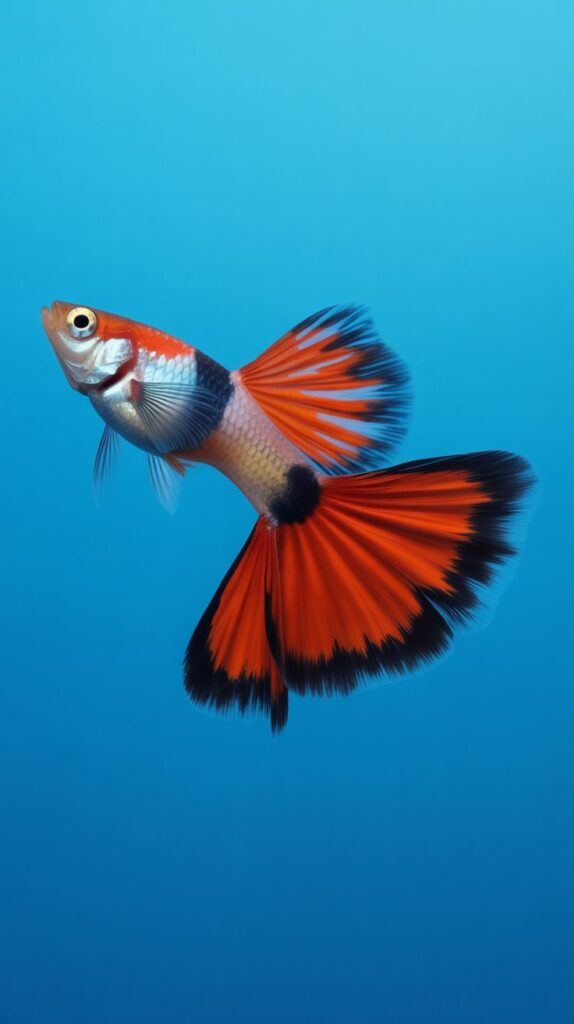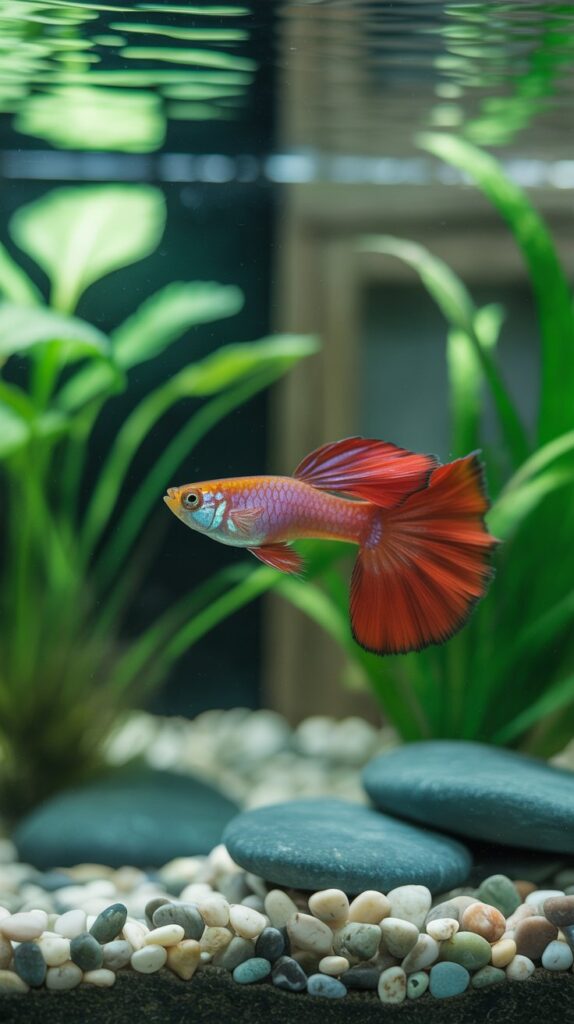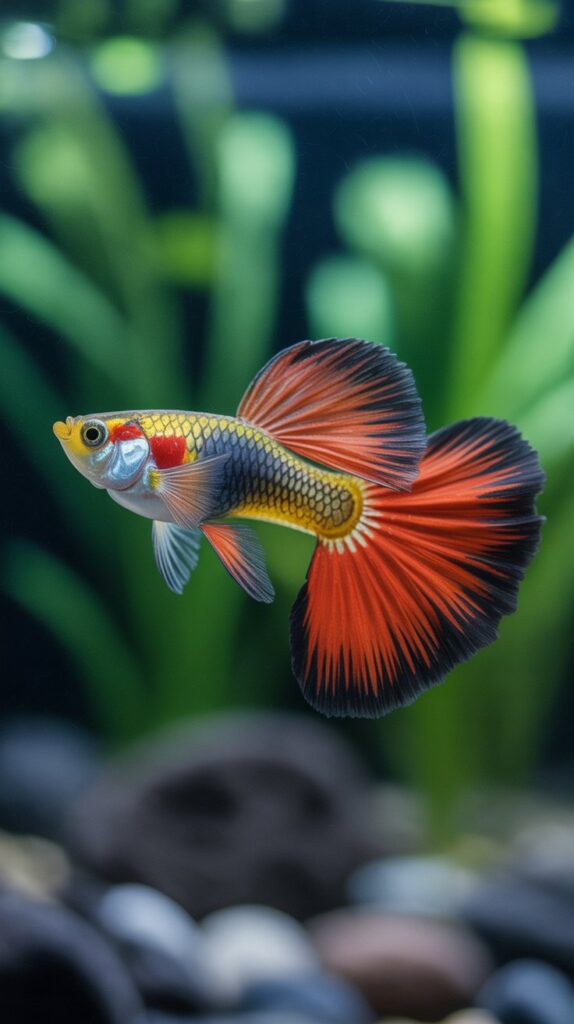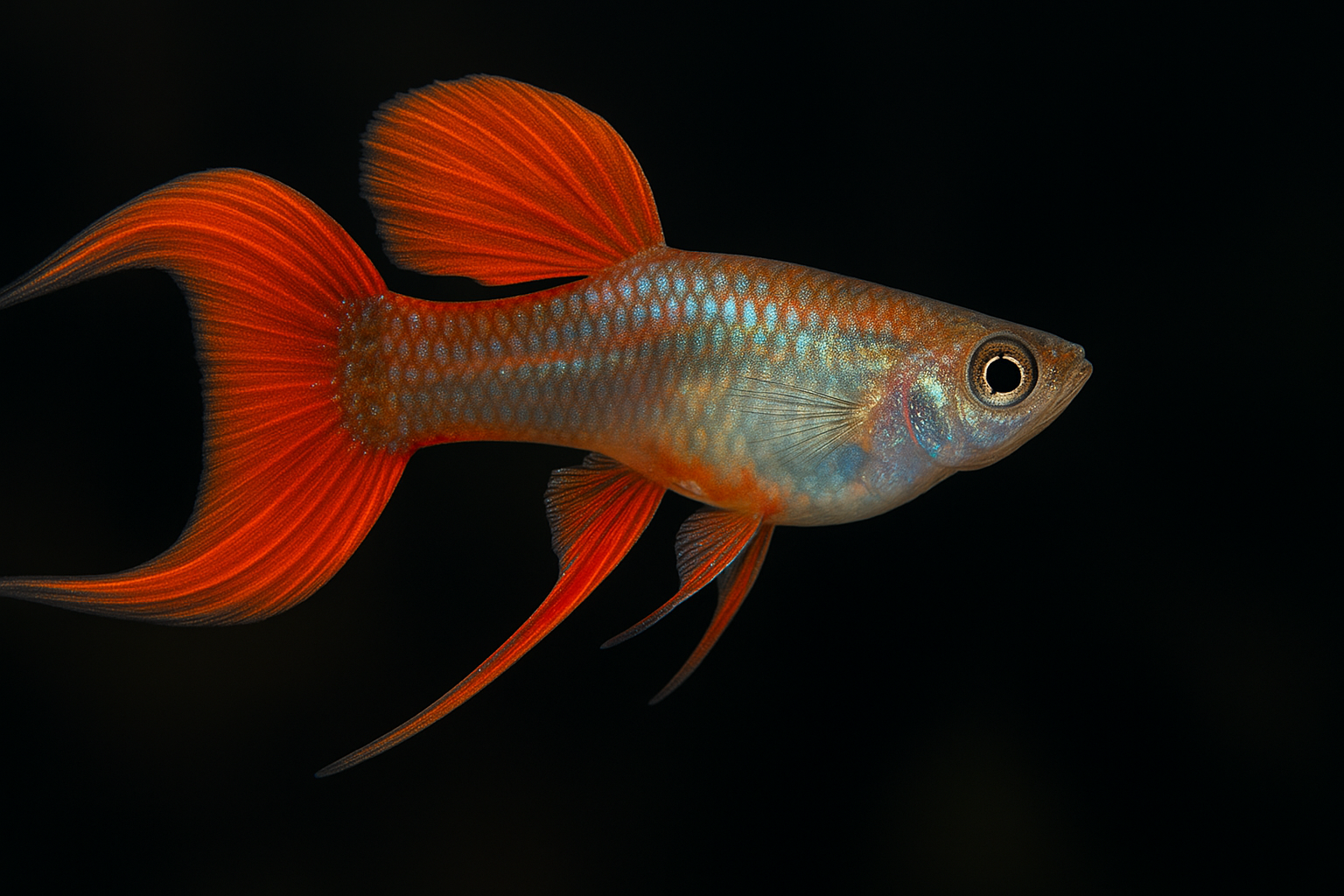The Red Lyretail Guppy is a captivating ornamental fish that adds elegance and vibrancy to any freshwater aquarium. With its brilliant red coloration and unique tail shape resembling a lyre—a classical musical instrument—this guppy variety has become a favorite among aquarists and breeders alike.
As a member of the Poecilia reticulata species, the Red Lyretail Guppy not only boasts visual appeal but also showcases the hardiness, adaptability, and lively nature typical of guppies. This article offers a comprehensive look at this beautiful fish, from its origin and physical traits to breeding, tank setup, diet, health care, and more.
Whether you are new to fishkeeping or an experienced aquarist, this 2000-word guide to the Red Lyretail Guppy will help you understand why this variety is worth adding to your tank.
1. Origins and Background
Guppies are native to South America, primarily found in Trinidad, Venezuela, Guyana, and northern Brazil. In their wild form, guppies exhibit less coloration and simpler tail shapes. Over decades, selective breeding has given rise to countless variations in body color, fin shapes, and patterns—one of which is the Lyretail.
The Lyretail guppy is named after its tail that resembles the strings and frame of a lyre. When combined with a vibrant red coloration, the Red Lyretail Guppy becomes one of the most visually striking guppy types in the hobby.
The Lyretail tail trait is recessive and genetically complex, which means it requires careful breeding to maintain. Despite that, it has gained popularity due to its graceful appearance and distinctive flowing fin structure.
2. Appearance and Coloration

The defining characteristics of a Red Lyretail Guppy lie in its bold color and tail morphology.
Key Physical Traits:
- Tail Shape: The lyretail consists of two elongated outer rays on the caudal fin that curve slightly outward, forming a forked or lyre-like shape. This fin type gives the fish an elegant, flowing appearance as it swims.
- Color: Deep, uniform red body and fins. The vibrancy may vary slightly based on genetics, diet, and lighting.
- Size: Males typically grow to 1.5 inches, while females can reach up to 2.5 inches.
- Fins: Long, flowing dorsal and caudal fins add to the fish’s ornamental appeal.
- Eyes: Usually black or dark brown, giving contrast to the red body.
This vibrant red and the refined lyretail make it a showstopper in community or solo tanks.
3. Ideal Tank Setup for Red Lyretail Guppies
Creating the right environment is crucial to maintaining the health and coloration of Red Lyretail Guppies. Fortunately, like most guppies, they are relatively hardy and easy to care for.
Tank Requirements:
- Minimum Tank Size: 10 gallons for a small group; larger tanks preferred for breeding or communities.
- Water Temperature: 74–82°F (23–28°C)
- pH Range: 6.8–7.8
- Water Hardness: 8–12 dGH
- Filtration: Sponge filters or low-flow systems to avoid damaging the delicate fins.
- Substrate: Sand or fine gravel to mimic natural environments.
- Lighting: Moderate LED lighting enhances the red hues of the guppies.
- Decor: Live plants like Java moss, Anubias, and guppy grass offer hiding spaces and breeding ground for fry.
Tank Mates:
Red Lyretail Guppies are peaceful and should be kept with similarly tempered species. Ideal tank mates include:
- Neon tetras
- Platies
- Mollies
- Swordtails
- Corydoras
- Amano shrimp
- Mystery snails
Avoid aggressive or fin-nipping species like tiger barbs, which can damage the lyretail fins.
4. Feeding and Diet

To keep your Red Lyretail Guppy healthy and vibrantly colored, a well-balanced diet is essential. They are omnivores and thrive on a variety of foods.
Recommended Foods:
- High-quality flake food: Provides essential nutrients.
- Frozen or live foods: Brine shrimp, bloodworms, daphnia.
- Vegetable matter: Spirulina flakes or blanched vegetables like spinach or zucchini.
- Micro pellets or granules: Specifically formulated for tropical fish.
Feeding Schedule:
Feed 2–3 times a day, giving only what they can consume in 2 minutes. Overfeeding can lead to bloating, swim bladder issues, and water quality degradation.
5. Behavior and Temperament
Red Lyretail Guppies are known for their active, peaceful, and social demeanor. Males are especially animated, often displaying courtship behavior by flaring their fins and chasing females.
Behavioral Traits:
- Social Fish: Do best in small groups.
- Peaceful Temperament: Ideal for community tanks.
- Active Swimmers: Constantly on the move.
- Breeding Displays: Males often display their fins to attract females.
They rarely show aggression, making them perfect for tanks with multiple species.
6. Breeding Red Lyretail Guppies
Breeding Red Lyretail Guppies is both rewarding and challenging due to the genetics involved in preserving the lyretail trait.
Key Breeding Notes:
- Livebearers: Females give birth to live fry instead of laying eggs.
- Mating Ratio: One male to two or more females helps reduce stress on females.
- Gestation Period: Around 28 days.
- Signs of Pregnancy: Enlarged belly, dark gravid spot, and hiding behavior.
Breeding Tank Setup:
- Use a separate breeding tank or breeding box.
- Provide dense live plants for fry to hide.
- Keep temperature steady around 78–80°F.
Raising Fry:
- Feed crushed flake food, baby brine shrimp, and micro worms.
- Change 20–30% of the water weekly.
- Separate fry from adults to prevent predation.
To preserve the lyretail gene, breed only lyretail guppies together. Cross-breeding with other tail types may result in offspring losing the characteristic tail shape.
7. Health and Common Diseases

Though hardy, Red Lyretail Guppies can fall ill due to poor water quality, stress, or infections.
Common Health Issues:
- Ich (White Spot Disease): Small white dots on body and fins. Treat with temperature elevation and medication.
- Fin Rot: Caused by bacterial infection; tail appears frayed or rotting.
- Swim Bladder Disorder: Fish has difficulty swimming properly.
- Velvet Disease: Rusty, gold-dust appearance on the skin.
- Fungal Infections: White cottony patches.
Prevention:
- Maintain clean water with regular changes (25–30% weekly).
- Avoid overstocking and overfeeding.
- Quarantine new fish before introducing them.
- Use a heater and thermometer to maintain stable temperature.
A stress-free environment with optimal parameters greatly reduces the risk of illness.
8. Advantages of Keeping Red Lyretail Guppies
- 🐠 Eye-Catching Appearance: Their vibrant red color and flowing tail make them stand out in any tank.
- 🐠 Beginner-Friendly: Suitable for novice aquarists due to their hardiness.
- 🐠 Easy Breeders: Great for hobbyists interested in selective breeding.
- 🐠 Peaceful Nature: Ideal for community tanks.
- 🐠 Small Space Requirement: Can be housed in smaller aquariums compared to larger species.
9. Where to Buy Red Lyretail Guppies

Red Lyretail Guppies can be found at local fish stores, aquarium expos, or online. Look for reputable breeders who maintain pure lyretail lines and good health practices.
What to Look For:
- Bright, uniform red coloration.
- Healthy fins and tail (no fraying).
- Active swimming and responsive behavior.
- No signs of disease or lethargy.
Prices can range from $3 to $10 depending on size, color quality, and breeding lineage.
10. Tips for Enhancing Color and Health
- Use color-enhancing flakes or spirulina.
- Keep a clean, stable tank environment.
- Provide live plants to reduce stress.
- Avoid mixing with aggressive or nippy fish.
- Ensure adequate swimming space for long-finned guppies.
A happy Red Lyretail Guppy will showcase its maximum color potential and thrive in your tank.
Conclusion
The Red Lyretail Guppy is an exquisite fish that combines vibrant color with a graceful tail design. Its peaceful nature, ease of care, and striking appearance make it a standout choice for both beginner and experienced aquarists. By maintaining good tank conditions, offering a balanced diet, and breeding responsibly, you can enjoy the beauty and vitality of these guppies for years to come.
Whether you’re building a stunning planted tank or exploring guppy genetics, the Red Lyretail Guppy is a rewarding companion in the world of freshwater aquariums.
Frequently Asked Questions (FAQs)
Q1: What makes a guppy a “Lyretail”?
A: A Lyretail guppy has an extended caudal fin with elongated tips that resemble a lyre. It is a recessive trait and needs selective breeding to maintain.
Q2: How do I maintain the red color in Red Lyretail Guppies?
A: Provide a diet rich in carotenoids (like in brine shrimp), use good lighting, and maintain stable, clean water conditions.
Q3: Are Red Lyretail Guppies harder to breed?
A: Breeding them is easy, but preserving the lyretail trait requires careful pairing of two Lyretail parents.
Q4: Can I keep Red Lyretail Guppies with Betta fish?
A: It’s not recommended due to potential aggression and fin-nipping. Bettas may also feel threatened by the guppy’s flowing fins.
Q5: How long do Red Lyretail Guppies live?
A: On average, they live for 1.5 to 2.5 years, but this can vary depending on care, genetics, and water quality.
Q6: How many Red Lyretail Guppies should I keep together?
A: At least 3–6 guppies are ideal to encourage natural behavior and reduce stress.
Q7: Can I mix Red Lyretail Guppies with other guppy types?
A: Yes, but doing so may dilute the lyretail trait in future generations unless breeding is controlled.
